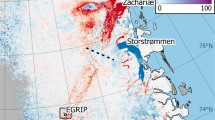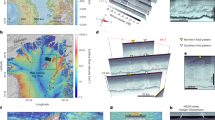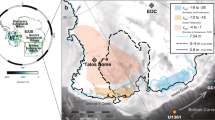Abstract
Marine ice-sheet collapse can contribute to rapid sea-level rise1. Today, the West Antarctic Ice Sheet contains an amount of ice equivalent to approximately six metres of sea-level rise, but most of the ice is in the slowly moving interior reservoir. A relatively small fraction of the ice sheet comprises several rapidly flowing ice streams which drain the ice to the sea. The evolution of this drainage system almost certainly governs the process of ice-sheet collapse2,3,4,5. The thick and slow-moving interior ice reservoir is generally fixed to the underlying bedrock while the ice streams glide over lubricated beds at velocities of up to several hundred metres per year. The source of the basal lubricant — a water-saturated till6,7 overlain by a water system8 — may be linked to the underlying geology. The West Antarctic Ice Sheet rests over a geologically complex region characterized by thin crust, high heat flows, active volcanism and sedimentary basins9,10,11,12,13,14,15,16. Here we use aerogeophysical measurements to constrain the geological setting of the onset of an active West Antarctic ice stream. The onset coincides with a sediment-filled basin incised by a steep-sided valley. This observation supports the suggestion5,17 that ice-stream dynamics — and therefore the response of the West Antarctice Ice Sheet to changes in climate — are strongly modulated by the underlying geology.
This is a preview of subscription content, access via your institution
Access options
Subscribe to this journal
Receive 51 print issues and online access
$199.00 per year
only $3.90 per issue
Buy this article
- Purchase on Springer Link
- Instant access to full article PDF
Prices may be subject to local taxes which are calculated during checkout




Similar content being viewed by others
References
Fairbanks, R. G. A17,000-year glacio-eustatic sea level record: Influence of glacial melting rates on the Younger Dryas event and deep-ocean circulation. Nature 342, 637–642 (1989).
MacAyeal, D. R. Irregular oscillations of the West Antarctic ice sheet. Nature 359, 29–35 (1992).
MacAyeal, D. R. Binge/purge oscillations of the Laurentide ice sheet is a cause of the north Atlantic's Heinrich events. Paleoceanography 8(6), 775–784 (1993).
Alley, R. B. & Whillans, I. M. Changes in the West Antarctic ice sheet. Science 254, 959–963 (1991).
Blankenship, D. D. et al. Active volcanism beneath the West Antarctic Ice Sheet and implications for ice-sheet stability. Nature 361, 526–529 (1993).
Blankenship, D. D., Bentley, C. R., Rooney, S. T. & Alley, R. B. Till beneath ice stream B.1. Properties derived from seismic travel times. J. Geophys. Res. 9, 8903–8911 (1987).
Engelhardt, H. Humphrey, N., Kamb, B. & Fahnestock, M. Physical conditions at the base of a fast moving Antarctic ice stream. Science 248, 57–59 (1990).
Engelhardt, H. & Kamb, B. Basal hydraulic system of a West Antarctic ice stream: constraints from borehole observations. J. Glaciol. 43, 207–244 (1997).
Dalziel, I. W. D. & Elliot, D. G. West Antarctica: problem child of Gondwanaland. Tectonics 1, 3–19 (1982).
Behrendt, J. C. et al. The West Antarctic Rift System-A Review of Geophysical Investigations 67–112 (Antarctic Res. Ser. 53, Am. Geophys. Union, Washington DC, 1991).
Cooper, A. K., Davey, F. J. & Hinz, K. in Geological Evolution of Antarctica (eds Thomson, M. R. A., Crame, J. A. & Thomson, J. W.) 285–292 (Cambridge Univ. Press, 1991).
Davey, F. J. The Antarctic Continental Margin: Geology and Geophysics of the Western Ross Sea 1–16 (Circum-Pacific Council for Energy and Resources, Houston, 1987).
Robertson, J. D., Bentley, C. R., Clough, J. W. & Greischar, L. L. in Antarctic Geoscience 1083–1090 (IUGS B4, Univ. Wisconsin Press, Madison, Wisconsin, 1982).
Rose, K. E. Characteristics of ice flow in Marie Byrd Land, Antarctica. J. Glaciol. 24, 63–74 (1979).
Ten Brink, U. S., Bannister, S., Beaudoin, B. C. & Stern, T. A. Geophysical investigations of the tectonic boundary between East and West Antarctica. Science 261, 45–50 (1993).
Rooney, S. T., Blankenship, D. D., Bentley, C. R. & Alley, R. B. Till beneath ice stream B.2. Structure and continuity. J. Geophys. Res. 9(B9), 8913–8920 (1987).
Retzlaff, R., Lord, N. & Bentley, C. R. Airborne-radar studies: Ice streams A, B and C, West Antarctica. J. Glaciol. 39(133), 495–506 (1993).
Hodge, S. M. & Doppelhammer, S. Onset of streaming flow of ice streams. J. Geophys. Res. 101, 6669–6677 (1996).
Scambos, T. A. & Bindshadler, R. A. Ice flow at the confluence of two ice stream tributaries revealed by sequential satellite imagery. Ann. Glaciol. 17, 177–182 (1993).
Bindschadler, R. A. & Vornberger, P. L. AVHRR imagery reveals Antarctic ice dynamics. Eos 71, 741–742 (1990).
Anandakrishnan, S., Blankenship, D. D., Alley, R. B. & Stoffa, P. L. Influence of subglacial geology on the position of a West Antarctic ice stream from seismic observations. Nature 394, 62–65 (1998).
Shabtaie, S. & Bentley, C. R. Ice-thickness map of the West Antarctic ice streams by radar sounding. Ann. Glaciol. 11, 126–135 (1988).
Drewry, D. J. Antarctica: Glaciological and Geophysical Folio (Cambridge Univ. Press, 1983).
Shabtaie, S. & Bentley, C. R. West Antarctic ice streams draining into the Ross ice shelf: configuration and mass balance. J. Geophys. Res. 92(B2), 1311–1336 (1987).
Anandakrishnan, S. & Alley, R. B. Stagnation of ice stream C, West Antarctica by water piracy. Geophys. Res. Lett. 24, 265–268 (1997).
Brozena, J. M. et al. CASERTZ 91-92: Airborne gravity and surface topography measurements. Antarc. J. US 28, 1–3 (1993).
Behrendt, J. C. et al. CASERTZ aeromagnetic data reveal late Cenozoic flood basalts in the West Antarctic rift system. Geology 22, 527–530 (1994).
Acknowledgements
We thank R. Arko, M. Studinger and S. Kempf for assistance. This Letter was improved by contributions from G. Karner and C. Small. This work was supported by the US NSF.
Author information
Authors and Affiliations
Corresponding author
Rights and permissions
About this article
Cite this article
Bell, R., Blankenship, D., Finn, C. et al. Influence of subglacial geology on the onset of a West Antarctic ice stream from aerogeophysical observations. Nature 394, 58–62 (1998). https://doi.org/10.1038/27883
Received:
Accepted:
Published:
Issue Date:
DOI: https://doi.org/10.1038/27883
This article is cited by
-
Scars of tectonism promote ice-sheet nucleation from Hercules Dome into West Antarctica
Nature Geoscience (2023)
-
Antarctic geothermal heat flow and its implications for tectonics and ice sheets
Nature Reviews Earth & Environment (2022)
-
Sedimentary basins reduce stability of Antarctic ice streams through groundwater feedbacks
Nature Geoscience (2022)
-
Uppermost crustal structure regulates the flow of the Greenland Ice Sheet
Nature Communications (2021)
-
The geological history and evolution of West Antarctica
Nature Reviews Earth & Environment (2020)
Comments
By submitting a comment you agree to abide by our Terms and Community Guidelines. If you find something abusive or that does not comply with our terms or guidelines please flag it as inappropriate.



